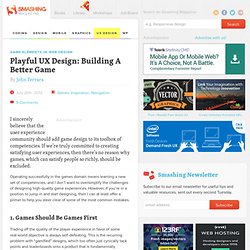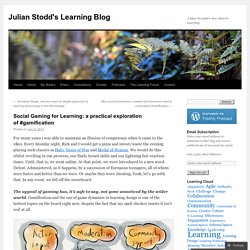

Playful UX Design: Building A Better Game. Advertisement I sincerely believe that the user experience community should add game design to its toolbox of competencies.

If we’re truly committed to creating satisfying user experiences, then there’s no reason why games, which can satisfy people so richly, should be excluded. Operating successfully in the games domain means learning a new set of competencies, and I don’t want to oversimplify the challenges of designing high-quality game experiences. However, if you’re in a position to jump in and start designing, then I can at least offer a primer to help you steer clear of some of the most common mistakes. 1. Trading off the quality of the player experience in favor of some real-world objective is always self-defeating. Schwab MoneyWise’s It’s Your Life game has a noble mission: to convince people to save more money for retirement and other long-term objectives. At each step in Schwab’s It’s Your Life game, the choice that will lead to a winning outcome is pretty obvious. 2. 3. 4. 5.
The Future Of Games In Education. Games and your brain: how to use gamification to stop procrastinating. 1.4K Flares Filament.io 1.4K Flares × It is Thursday afternoon.

Hump day. You are being humped. The one thing you wished to accomplish today remains unaccomplished, sitting there as a painful reminder of your failure, goading you to check Tumblr just one more time. You lack motivation, clearly. And there’s your answer! Turning repetitive tasks into games is the secret sauce to getting things done.
Where did gamification come from in the first place? The idea behind gamification—challenge, motivation, reward— have been present in video games from the start, and it was gaming’s growth from niche to mainstream in the 2000s that helped push game mechanics into new industries and fields. The spark for the gamification boom is often traced to technology apps like Foursquare, which popularized ubiquitous badges for highly engaged users, and social games like Zynga’s FarmVille, which achieved huge commercial success on Facebook with its infinite reward system. Endorphins power our love for games. De Nederlandse e-learning portal > Onderzoek naar serious games?
“Serious games base training to deal with difficult dialogues and stressful situations” door Lucia Pannese.

Ik werd getriggered door de combinatie van ‘serious games’ en ‘stressful situations’ in de titel. Bij CELSTEC hebben we voor de UNHCR met ARLearn namelijk ook een serious game ontwikkeld waarmee een crisis-situatie (gijzeling) nagebootst wordt, en ik was benieuwd naar eventuele overeenkomsten en verschillen. Na de verplichte inleiding - snelgroeiende markt van serious games, de voordelen van emersion en motivatie – bleek het hier om een iets andere, maar daarom niet minder relevante context, te gaan, namelijk de gezondheidszorg.
De gepresenteerde game heeft als doel om verplegers/sters om te leren gaan met lastige patienten: iets waar hun reguliere opleiding onvoldoende in voorziet. De 15 minuten durende presentatie over de Clinic-game bleek aan het eind feitelijk heel goed samengevat te worden in het filmpje dat vervolgens vertoond werd. Wat heb ik van de presentatie geleerd? Social Gaming for Learning: a practical exploration of #gamification. The appeal of gaming has, it’s safe to say, not gone unnoticed by the wider world.

Gamification and the use of game dynamics in learning design is one of the hottest topics on the board right now, despite the fact that my spell checker insists it isn’t real at all. Example of a Social Gaming approach, where the core event is surrounded by social inputs and social learning spaces One of my areas of interest is in social gaming, introducing both social learning elements and game dynamics to learning solutions, so in this article i want to introduce one such approach in the form of scaffolded simulations with a social learning backbone.
I do this to illustrate some of the potential and some of the challenges, but also to give what i hope is a practical illustration of something that, with a little work, you could implement this year. What can it look like? We create a core event, let’s say for a group of first responders in an emergency.